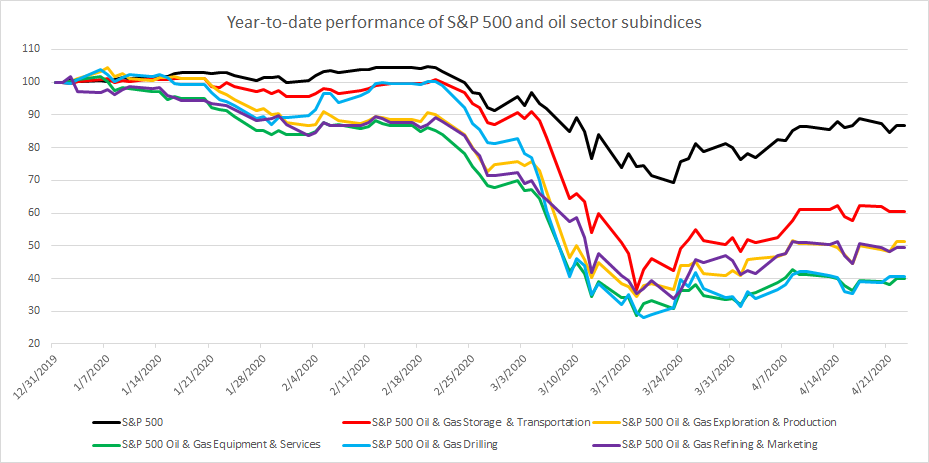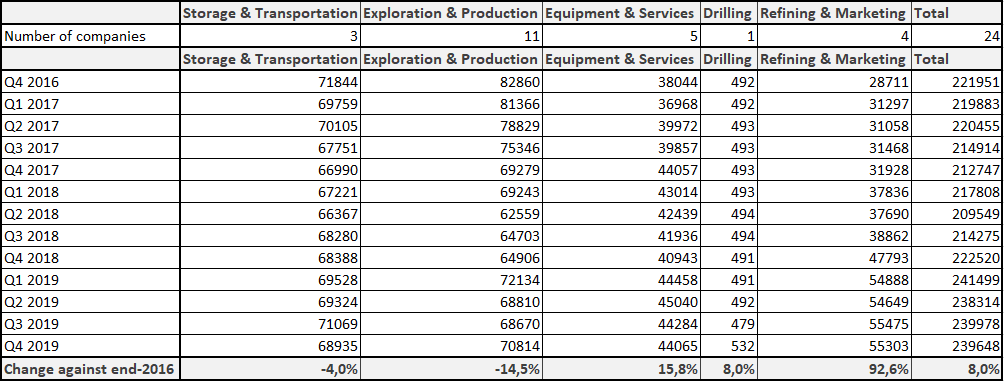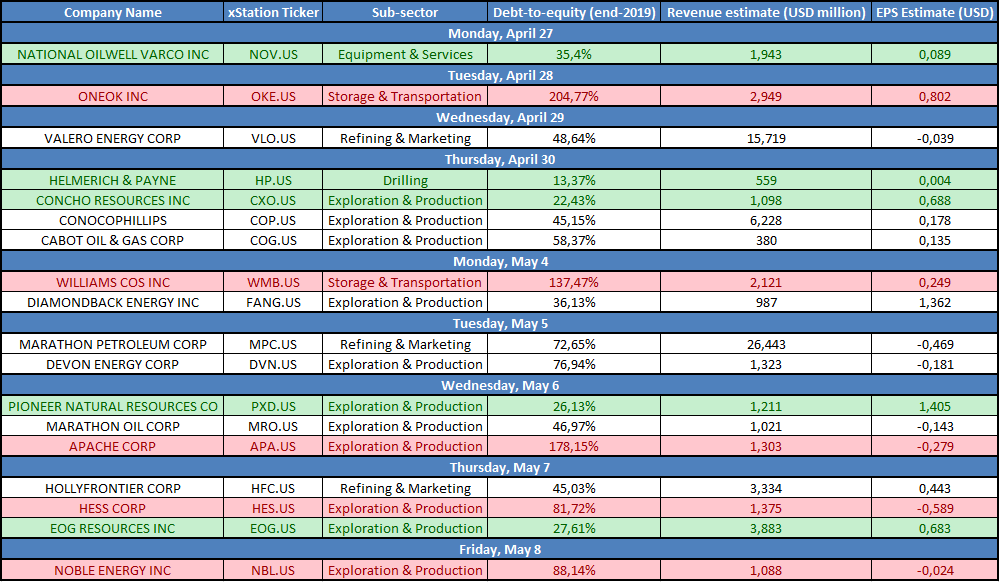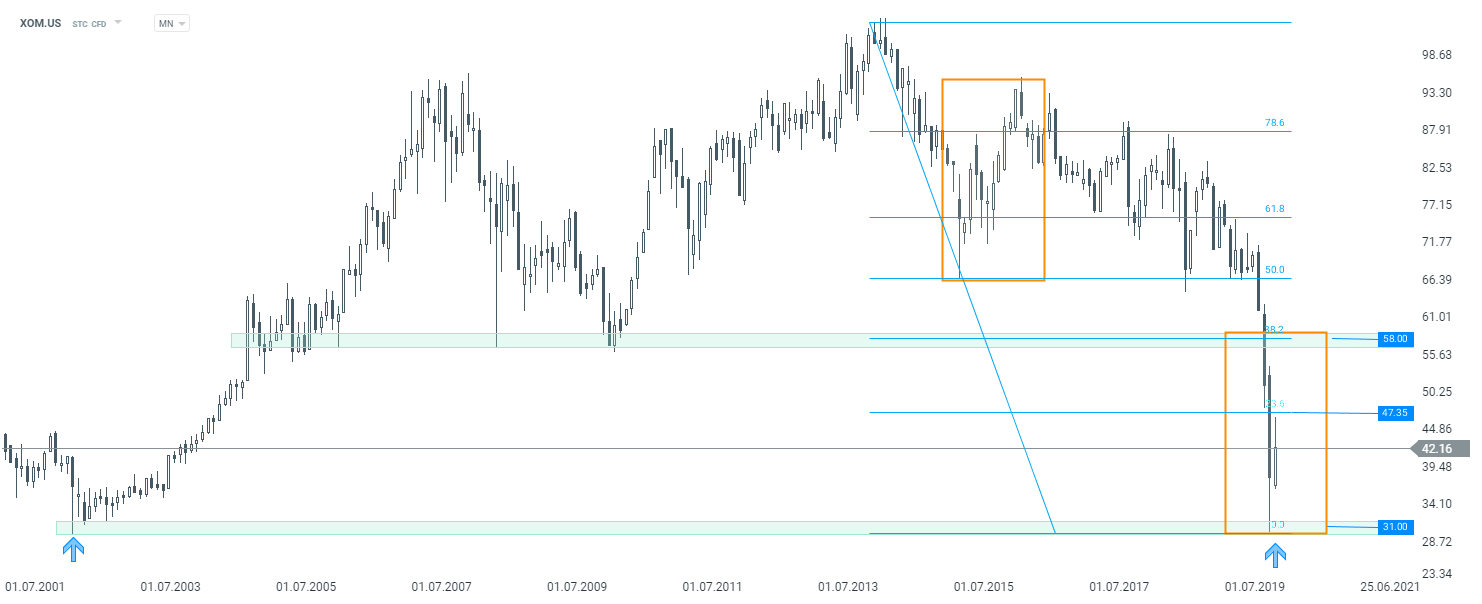-
Oil market suffered the worst day in history on Monday
-
National lockdowns and aircraft groundings depress demand
-
Massive decline in oil prices leaves US companies vulnerable
-
Years of growth financed through debt
-
Integrated oil companies look to be the most resilient
Oil is in the spotlight this week following a massive crash in the front-month contract on Monday. Demand destruction and storage issues pushed price into negative territory. It goes without a question that the US oil sector has found itself in a very uncomfortable position. However, not all oil companies are uniform and in this short commentary we will take a look at potential winners and losers.
Oil sector underperforms broad market this year
Coronavirus pandemic and related lockdowns and aircraft groundings took out a huge chunk of demand. To make things worse for oil prices, Saudi Arabia and Russia engaged in a price war. While the price war ended and an agreement was reached between major oil producers, the price of crude failed to rebound. This is the reason why oil companies keep underperforming S&P 500. As one can see on the chart below, companies from Equipment & Services and Drilling subindices of the S&P 500 oil sector index took the biggest hit in anticipation of lower Capex needs of the sector in the quarters to come. Oil Storage & Transportation companies can be seen as "winners" but they also trail performance of the broad market index. Interestingly, Storage & Transportation companies did not see much of an impact from recent storage issues.
 Oil sector is underperforming the S&P 500 significantly this year. Note that oil sector subindices were trailing the broad market even before the coronavirus pandemic became a global issue. Contrary to popular belief, oil storage & transportation companies failed to rally on recent storage issues. Source: Bloomberg, XTB Research
Oil sector is underperforming the S&P 500 significantly this year. Note that oil sector subindices were trailing the broad market even before the coronavirus pandemic became a global issue. Contrary to popular belief, oil storage & transportation companies failed to rally on recent storage issues. Source: Bloomberg, XTB Research
Growth financed through debt
The big problem of the US shale sector is its balance sheet. Years of economic boom and relatively cheap loans allowed US companies to greatly increase output by taking on additional debt. The United States became the world's largest oil producer. However, the majority of the US production comes from shale and production sites in shale basins often have higher break-even prices than traditional sites. It was not much of a problem at the beginning of a previous decade when WTI price sat comfortably above $80 per barrel. Things changed after a 50% price drop in 2014 that significantly deteriorated the position of the US producers. Now it is highly likely that every US shale producer is operating in the red amid current prices. WTI price dropped to a multi-year low of $26.50 in early-2016. Having above in mind, it goes without saying that it was below break-even prices for US producers. That should have been a warning sign that oil prices can actually be that low and should have urged US companies to scale down debt. Table below shows that, unfortunately, in most sub-sectors nominal debt increased.
 Combined debt (USD million) for companies being members of the S&P 500 oil sub-sectors in 2020. Those 24 S&P 500 members had a combined debt pile of almost $240 billion at the end of 2019! Source: Bloomberg, XTB Research
Combined debt (USD million) for companies being members of the S&P 500 oil sub-sectors in 2020. Those 24 S&P 500 members had a combined debt pile of almost $240 billion at the end of 2019! Source: Bloomberg, XTB Research
Debt is the biggest problem
Actually, it is highly likely that every US shale producer is operating in the red amid current prices. However, there must be some companies that are more at risk than others. Debt levels could help find such vulnerable companies. For instance, big jump in nominal debt levels of Marketing & Refining sub-index (see table above) can be reasoned with Marathon Petroleum (MPC.US) more than tripling in the period. The rule of thumb is that companies with higher debt-to-equity ratios are more exposed to an adverse turn in market conditions, like the one we are observing right now. In the table below we have provided some basic information for traders of US oil stocks, including earnings release dates and debt-to-equity ratios at the end of 2019 (note that those have likely increased following market sell-off in Q1 2020).
 All of the US oil companies from the S&P 500 index will report earnings over the next two weeks. Some basic data can be found in the table. Companies with highest debt-to-equity ratios were marked in red while those with the lowest were marked in green. Note that 7 out of 18 comapnies in the table are expected to report loss already in Q1 2020. Keep in mind that those dates are subject to change. Source: Bloomberg, XTB Research
All of the US oil companies from the S&P 500 index will report earnings over the next two weeks. Some basic data can be found in the table. Companies with highest debt-to-equity ratios were marked in red while those with the lowest were marked in green. Note that 7 out of 18 comapnies in the table are expected to report loss already in Q1 2020. Keep in mind that those dates are subject to change. Source: Bloomberg, XTB Research
It's safer to focus on integrated oil companies
We have intentionally omitted one group of US oil stocks in our analysis - integrated oil companies. Those are companies that operate in more than one segment of the oil sector and very often in all of them at once. There are 3 such companies in the S&P 500 index - ExxonMobil (XOM.US), Chevron (CVX.US) and Occidental Petroleum (OXY.US). Occidental has a massive debt pile following acquisition of Anadarko therefore it is also at risk but Chevron and Exxon look better. Those companies do not have as much debt (Chevron had debt-to-equity of 21.25% at end-2019 while Exxon had this ratio at 26.45%) and their size will help them weather the crisis. As a wave of bankruptcies in the US oil sector is highly likely, it is also highly likely that it will be either Exxon or Chevron who will be picking up assets of companies that are forced out of the market. Needless to say purchases of assets from troubled companies could come at bargain prices. From this point of view, big US oil companies could benefit from the ongoing situation and potential down-scaling of the US shale sector in near future.
 Betting on outperformance of Chevron or Exxon is a long-term play and, in turn, charts should be analyzed at a higher timeframe. Taking a look at ExxonMobil (XOM.US) on the monthly time frame, one can see that the stock halted the February-March sell-off at a low from mid-2002 ($31 area). Big-time resistance for the stock can be found in the $58 area - combination of 38.2% retracement of a drop started in mid-2014 and the upper limit of the Overbalance structure. Nevertheless, recovery is likely to be conditioned on the situation in the oil market. Source: xStation5
Betting on outperformance of Chevron or Exxon is a long-term play and, in turn, charts should be analyzed at a higher timeframe. Taking a look at ExxonMobil (XOM.US) on the monthly time frame, one can see that the stock halted the February-March sell-off at a low from mid-2002 ($31 area). Big-time resistance for the stock can be found in the $58 area - combination of 38.2% retracement of a drop started in mid-2014 and the upper limit of the Overbalance structure. Nevertheless, recovery is likely to be conditioned on the situation in the oil market. Source: xStation5
Quantum Computing after Earnings: Quantum Breakthough?
Alibaba sell-off extends amid White House national security concerns📌
US Earnings Season Summary 🗽What the Latest FactSet Data Shows
US Open: US100 initiates rebound attempt 🗽Micron shares near ATH📈


